
Whether you’re shopping for your very first bass guitar, or your 5th…it never really gets much easier.
Because compared to the vast majority of other musical instruments…
With the bass in particular:
- There’s tons of makes/models
- With tons of different features
- And tons to know about the instrument as a whole
So to help makes sense of things, in this ultimate buyer’s guide, I’m going to give you a crash-course on everything you as a player should know when shopping for your next bass gutiar.
First up…
4 vs 5 vs 6 String Bass Guitars: What’s the Difference?

While bass guitars are commonly thought of as a 4-stringed instrument (since that’s what 95% of players prefer)…
The fact is, more and more players nowadays prefer either the 5 or 6 string models instead.
Compared to 4 string basses:
- 5 string basses – have an extra B string on the low end, which allows for a deeper bass range with heavier styles of music.
- 6 string basses – have the same B string as well, in addition to an extra high C string, which allows for more range with soloing and progressive styles of play.
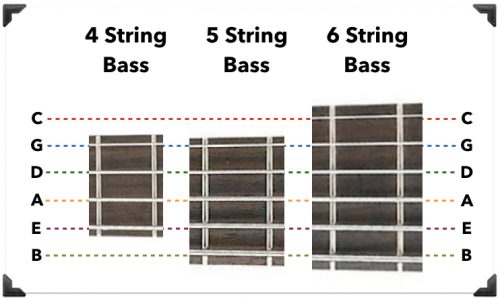
The reason most players choose NOT to use these extra string(s) is that they’re unnecessary for almost all playing styles and only serve to add extra width to the neck…making the instrument more difficult to handle overall.
So unless you’re an advanced player with a specific reason to switch to 5 or 6 strings, I highly recommend sticking to 4.
The 3 Standard Scale Lengths of a Bass Guitar
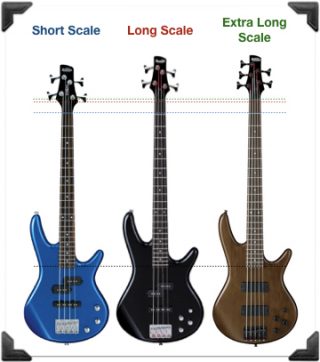
What many players don’t know is:
Bass guitars actually come in 3 sizes (commonly referred to as “scale lengths”:
- 34″ – aka long scale
- 30″ or less – aka short scale
- 35″ or more – aka extra long scale
These days, long scale is considered standard, and is the best default option unless you have a specific reason to choose otherwise.
Short scale basses are ideal for young or small players, as their size and weight is easier to handle.
The main side downside of these basses is…since the strings are shorter, they are also floppier and have a somewhat darker sound.
Extra long scale basses are mainly used on 5 or 6 string basses, as the added length is necessary for the lower B string.
The Pros vs Cons of Fretless Bass Guitars
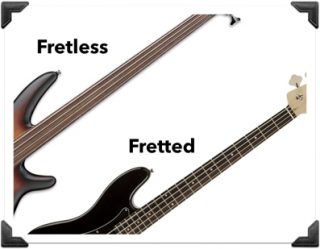
Another advanced option that some players transition to (after many years of experience)…is fretless basses.
With standard bass guitars, metal frets are used to mark off the exact spots where the strings must be “fretted”…
In order to only play notes that are in-tune with all the rest.
However…with fretless basses, it is up to the player to both find and hear those exact notes on his own…much like you would do with a traditional upright bass, cello, or violin.
As you might imagine, starting out on a fretless bass is not advisable, because:
- It’s much harder to get the hang of
- The vast majority of popular music is played on fretted basses
So as a beginner…stick with the frets.
The Industry Standards in Bass Guitars
So far in this post we’ve established 3 concrete tips for beginner-intermediate bass players.
- Stick to a 4 string
- Stick to long scale
- Stick to fretted
And for the most part, this is all your really need to know before you start comparing actual makes/models.
And while there are literally hundreds to choose from, there are really only TWO in particular to definitely consider…
As they’ve been industry standards ever since the electric bass guitar was first invented…and have gone mostly unchanged for the last half century.
They are:
- Fender Precision Bass (P-Bass)
- Fender Jazz Bass
So up next…
Precision vs Jazz Bass: What’s the Difference?

As you can see in the picture, the differences between them aren’t entirely obvious. So let’s discuss them now…
The 3 notable differences between the P-Bass and Jazz Bass are:
- Body Shape
- Neck Contour
- Pickup Design
For the body design…
The original P-Bass was modeled after the shape of the 1954 Fender Stratocaster, while the Jazz Bass was modeled after the 1960 Fender Jazzmaster.
While the visual differences between the two may be subtle, the Jazz Bass actually has a center of gravity closer to the neck, which some may argue…offers better balance for the player.
For the neck contour…
The Precision Bass has a more consistent width and less taper towards the headstock.
The Jazz Bass on the other hand, has a noticeably steeper taper, which brings the strings closer together towards the nut, and potentially offers a more comfortable grip.
For the pickup design…
Which is arguably the most significant difference between the two in terms of sound, the P Bass features split 4-pole single-coil pickups, while the Jazz Bass features dual 8-pole humbuckers.
And while the topic of pickups is quite complex and outside the scope of this article, it’s worth noting that neither of these two pickup designs is better than the other…just different.
But as a standard rule of thumb, single-coil pickups sound thinner and noisier, while humbuckers generally sound fatter and cleaner.
By these descriptions, you’d think that humbuckers would be the superior option, and for many people, they are. However, the alternative wouldn’t exist if a significant number of players didn’t prefer it instead.
Squier vs Fender Bass Guitars: What’s the Difference?
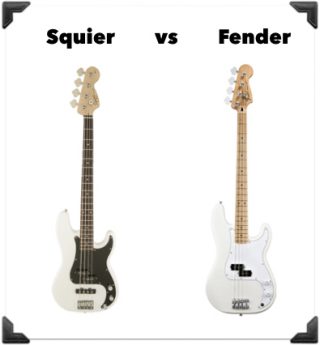
Assuming you’ve narrowed down your options to one industry standards we just covered…
The question to now ask yourself is: how much should I spend?
Because the P-Bass and Jazz both come in several sub-models at a wide range of prices.
Luckily though, with almost any name-brand bass guitar in this day and age, you’ll still get a quality instrument regardless of the price.
In fact, any of the following Squier (Fender’s line for beginners) models would be absolutely PERFECT as a first bass guitar for beginners:
- Affinity Jazz Bass – (Amazon/Thomann)
- Mini Precision Bass – (Amazon/Thomann)
- Classic Vibe 50’s P-Bass – (Amazon/Thomann)
- Classic Vibe ’70s P-Bass – (Amazon/Thomann)
- Squier Bronco Bass – (Amazon)
Now if you’re looking to upgrade, or you’re lucky enough to afford whatever you want…
Here are the links to the more high-end Fender versions:
- Player P Bass – (Amazon/Thomann)
- American Professional P Bass – (Amazon)
- Player Jazz Bass – (Amazon)
- American Professional Jazz Bass – (Amazon/Thomann)
- 50’s P Bass – (Amazon/Thomann)
- Mustang PJ Bass – (Amazon/Thomann)
- Geddy Lee Signature – (Amazon/Thomann)
- Flea Signature Jazz Bass – (Amazon/Thomann)
NOTE: Some of the links above are labeled as a “PJ Bass”, which means that the pickups feature a P-Bass pickup nearest the neck, and a Jazz Bass pickup nearest the bridge.
The Best “Other” Bass Guitar Options
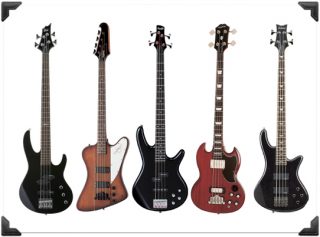
If you don’t really like the vibe of Fender basses, or you’re just curious to see what other options exist…
Here is a complete list the most popular and well-reviewed bass guitars on the market today, made by brands other than Fender:
For a more “classic” look:
- Epiphone EB-3 SG Bass – (Amazon/Thomann)
- Hofner Ignition Series – (Amazon/Thomann)
- Sterling by Music Man – (Amazon/Thomann)
- Epiphone Thunderbird IV – (Amazon/Thomann)
And for a more “modern” look:
- ESP LTD B-204SM – (Amazon/Thomann)
- Schecter Omen Extreme – (Amazon/Thomann)
- Schecter Stiletto Extreme – (Amazon/Thomann)
- Ibanez GSR200 – (Amazon/B&H/Thomann)
- Epiphone Thunderbird E1 – (Amazon)
Up next…
Advanced Upgrades for Advanced Bass Players
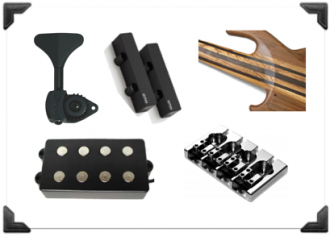
For some reason, once bass players get bored with their first instrument, and begin looking for something new…
Rather than just dropping a bunch of cash on a name-brand, fully-loaded, “ready-to-play” bass…
They instead tend to prefer the “do-it-yourself” route of mixing and matching different parts to build a unique one-of-a-kind instrument.
So right now, let’s fast-forward a bit in your musical career, and take a look at the 5 main features you will need to understand to customize your bass later on in the future.
Which Woods Are Ideal for Electric Bass Guitars?
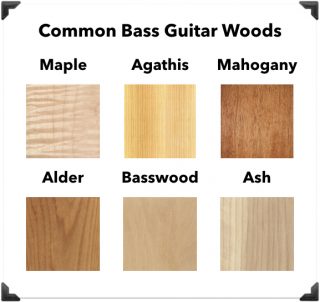
With bass guitars, more so than electric guitars, the woods used have a significant impact on:
- resonance
- tone
- playability
The 6 commonly used woods are:
- Alder – which is most common, due to its balance, clarity, and versatile sound.
- Ash – which is a common alternative to alder, with a slightly brighter sound.
- Maple – which is a dense wood with a bright sound and long sustain, that can be ideal for studio recording.
- Mahogany – which is dense wood with a warmer sound and long sustain.
- Basswood – which is typically used on cheaper instruments, as it as softer, with a shorter sustain. In some cases though, the short sustain can be ideal for fast, complex basslines.
- Agathis – which is another common option for cheaper basses.
Bass Guitar Necks: Bolt-on, Thru-Body, or Set?
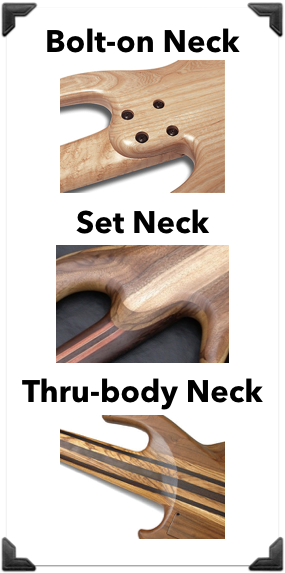
With electric bass guitars, the neck attachment is a particularly important feature…
Because the long heavy strings can be extremely stressful on a weak neck joint.
The 3 commonly used methods of attachment are:
- Bolt-on Necks
- Set Necks
- Thru-Body Necks
Bolt-on necks are most common because they are the easiest to assemble, and easiest to adjust.
But they are also the least stable, and offer the least sustain.
Yet despite these facts, bolt-on necks are still the stardard on most high-end stock models.
Set Necks, which are are a bit tougher to properly attach, typically offer better sustain than bolt-ons, as they have a larger overlap between the body and neck.
As such, they are often found on higher-end boutique guitars.
Thru-body necks, which are the most difficult to execute, and most expensive, but offer the greatest stability and sustain…
Are typically only found on individually produced custom-designed instruments.
Single-Coils vs Humbuckers: Which is Better for Bass?
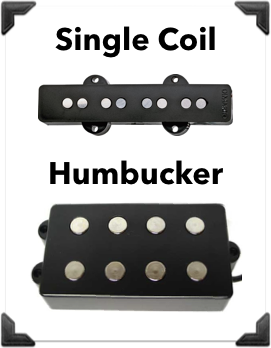
In order to convert string vibrations into an actual sound exiting the ampl…
Bass pickups work using a series of magnets under the strings which encode the information into an electric signal…
Which is then sent through the cable, to the amp, where it is decoded back into sound.
The two standard pickup designs, known as “single-coils” and “humbuckers”…each have their own set of pros and cons.
As we mentioned earlier:
- Single-coils – have a thinner, brighter sound, with more noise, and a lower output.
- Humbuckers – have less noise, with a warmer, rounder sound, and higher output.
On the Fender Precision Bass, a pickup design known as “split-coil” humbuckers is used, which essentially offers the best-of-both-worlds between the two.
As you gain more experienced with bass playing…you may or may not one day want to experiment with different pickup options to find your own “signature” sound.
Passive vs Active Electronics: Which is Better and Why?
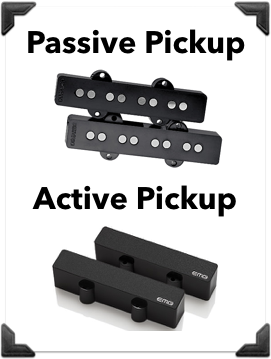
Regardless of whether you’re using single-coil or humbucker pickups, a certain voltage must be generated in order to create a useable signal.
And this is achieved in 1 of 2 ways:
- actively – meaning a battery-powered preamp in the pickup is used to boost the signal generated by the magnets
- passively – meaning a stronger magnet is used to generate the signal in the first place
While passive pickups are simpler to use and require less tweaking…they also offer less control as well. Which is one reason why many bass players prefer active pickups.
The main reason though, is that on bass guitars especially, they just sound better in many ways.
With all other factors being equal, active pickups typically have:
- less noise
- better harmonics
- more attack
- longer sustain
- increased headroom
Yet despite all these advantages, for some reason it’s more common to find stock bass guitars with passive pickups, rather than active. So to use active pickups, you’ll often need to install them yourself.
What You Need to Know About Bridges and Tuning Keys
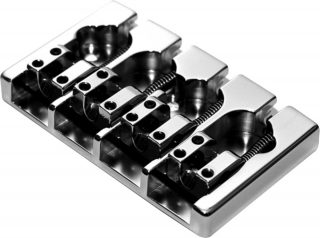
The final bass guitar upgrade to consider is the hardware.
Which means two things specifically:
- the bridge
- the tuning keys
With upgraded bridges, the two main goals are:
- better sustain and vibration transfer – which occurs simply by building it from a heavier metal such as brass.
- better string positioning – which occurs by adding precise horizontal adjustments for intonation, and vertical adjustments for action
Some of the top brands for high-end bass bridges include:
- Hipshot
- Babicz
- Gotoh
- Shaller
- Fender
With upgraded tuning keys, the 2 main goals are:
- tuning precision – which occurs by using higher gear ratios of around 20:1.
- tuning stability – which occurs simply by using better parts built with better craftsmanship.
Some of the top brands to check out include:
- Hipshot
- Gotoh
- Shaller
By the way, if you found this post useful, I highly recommend joining our free Home Recording Secrets email newsletter where you’ll discover….
- How to Get Your First Studio Up and Running in a Single Weekend
- How to Avoid Wasting Thousands of Dollars on Unnecessary Pointless Purchases
- How to Get a “Million Dollar” Pro Studio Sound in a “Thousand Dollar” Home Studio
- PLUS… All Sorts of Other Amazing Insider Secrets Revealed
And it’s totally FREE! Click here and Enter Your Email to Sign Up.
More Guitar Posts in This Series:
Electric Guitar | Acoustic Guitar | Bass Guitar | Amps | Pedals | Cables | Pickups | Bass Strings | Bass Amps | Bass Pickups | Classical Guitars | Acoustic Pickups | Direct Boxes | Cases | Picks | Slides | Straps | Tuners | Stands | Strings | Capos | Tabs | Guitar Accessories